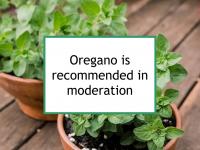Oregano (Origanum vulgare) is a culinary herb in the mint family with strong antioxidant and anti-inflammatory properties. It contains a variety of volatile oils, including thymol, eugenol, carvacrol and some limonene, which give the herb its characteristic scent and flavor. Although similar in flavor, Mexican oregano (Lippia graveolens) belongs to a different plant family.
Oregano is also a dietary source of apigenin, beta-carotene, caffeic acid, calcium, ferulic acid, iron, lutein, luteolin, manganese, myricetin, oleanolic acid, quercetin, rosmarinic acid, ursolic acid and vitamin K. However, the chemopreventive micronutrients with most significant content are quercetin, ferulic acid and ursolic acid.
Oregano has been used extensively for centuries as herbal medicine for its antiseptic and antibiotic properties, treating digestive and respiratory conditions such as nausea, diarrhea, and asthma, as well as fever. However, while there are a multitude of studies pertaining to the micronutrients in oregano, few studies have attempted to address the chemopreventive potential of oregano as a whole food.
Breast cancer-related effects of eating oregano
One 2016 study evaluated the anti-tumor effects of oregano in an animal of breast cancer model and also in ER+/PR+ breast cancer cells. Rats who received low-dose oregano concentrate in their diets were found to have 56% fewer tumors and 45% lower tumor volume compared to control animals. The results demonstrated for the first time, according to the authors, a distinct tumor-suppressive effect for oregano in an animal model of breast cancer.
The remaining evidence for the chemopreventive effects of oregano all depends on evidence concerning micronutrients found in the herb. While oregano compromises numerous compounds that have been shown to reduce breast cancer development, growth or metastasis, the concentrations in oregano are modest.
Quercetin
Quercetin is a phytoestrogen flavonol found in a variety of fruits and vegetables. Most foods with significant quercetin content have been found to be associated with reduced breast cancer risk. A major Italian population study reported that the risk of breast cancer was reduced for increasing intake of flavonols such as the quercetin found in oregano.
Quercetin has been shown to increase the effectiveness of both doxorubicin and paclitaxel chemotherapy in multidrug resistant ER+/PR+ breast cancer cells, in part by eliminating cancer stem cells. In addition, quercetin has been reported to increase the sensitivity of ER+/PR+ cells to 5-fluorouracil (5-FU), thereby increasing its treatment effects. Quercetin has also been found to inhibit the migration and adhesion of triple negative (ER-/PR-/HER2-) breast cancer cells and to significantly inhibit tumor progression in a mouse model of triple negative breast cancer. Finally, quercetin also acts as an iron chelator, which can help reduce iron's breast cancer-promoting effects in some women.
Ursolic acid
Ursolic acid has been shown to inhibit tumor formation and growth in all of the major breast cancer types (ER+/PR+, HER2+ and triple negative). Ursolic acid has also been shown to reverse multidrug resistance in breast cancer cells. One study found that ursolic acid reversed resistance to paclitaxel in paclitaxel-resistant triple negative breast cancer. Another study reported that ursolic acid resensitized multidrug resistant ER+/PR+ breast cancer cells to doxorubicin. Still another study published in 2021 demonstrated that ursolic acid also increased the sensitivity of triple negative breast cancer cells to doxorubicin.
Ferulic acid
Ferulic acid has been shown to induce programmed cell death in triple negative breast cancer cells. Ferulic acid has also been shown to synergistically enhance the treatment effects of doxorubicin, paclitaxel, epirubicin and tamoxifen. In addition, ferulic acid has been demonstrated to reduce the heart damage caused by doxorubicin in an animal study of doxorubicin-induced cardiomyopathy.
Rosmarinic Acid
Rosmarinic acid has been shown to inhibit proliferation and induce apoptosis (programmed cell death) of triple negative and ER+/PR+ breast cancer cells. Rosmarinic acid has also been reported to reduce the viability and migration of triple negative breast cancer stem cells. In addition, rosmarinic acid has been demonstrated to inhibit the migration of bone-homing breast cancer cells in a dose-dependent manner.
Rosmarinic acid has also been reported to enhance the treatment effects of the chemotherapy drugs doxorubicin, cisplatin, 5-FU, paclitaxel and (docetaxel). In addition, rosmarinic acid has been demonstrated to reduce doxorubicin-induced cardiomyopathy without reducing its cytotoxic effects against ER+/PR+ breast cancer cells.
Additional comments
Given that it is often grown with high levels of pesticides, oregano should be purchased organic. Even organic oregano tends to incorporate meaningful levels of heavy metals, which is why it should be consumed in moderation. Oregano pesto should probably be avoided.
Based on the available evidence, the amounts of oregano normally used as a herb or spice in food are safe, however oregano oil in medicinal amounts has not been adequately studied and has not been proven safe.
Sources of information provided in this webpage
The information above, which is updated continually as new research becomes available, has been developed based solely on the results of academic studies. Clicking on any of the underlined terms will take you to its tag or webpage, which contain more extensive information.
Below are links to 20 recent studies concerning this food and its components. For a more complete list, including less recent studies, please click on oregano.
